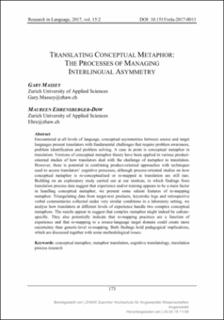Please use this identifier to cite or link to this item:
https://doi.org/10.21256/zhaw-2681| Publication type: | Article in scientific journal |
| Type of review: | Peer review (publication) |
| Title: | Translating conceptual metaphor : the processes of managing interlingual asymmetry |
| Authors: | Massey, Gary Ehrensberger-Dow, Maureen |
| DOI: | 10.1515/rela-2017-0011 10.21256/zhaw-2681 |
| Published in: | Research in Language |
| Volume(Issue): | 15 |
| Issue: | 2 |
| Page(s): | 173 |
| Pages to: | 189 |
| Issue Date: | 2017 |
| Publisher / Ed. Institution: | De Gruyter |
| ISSN: | 2083-4616 |
| Language: | English |
| Subjects: | Translation process research; Metaphor translation; Cognitive translatology; Conceptual metaphor |
| Subject (DDC): | 418.02: Translating and interpreting |
| Abstract: | Encountered at all levels of language, conceptual asymmetries between source and target languages present translators with fundamental challenges that require problem awareness, problem identification and problem solving. A case in point is conceptual metaphor in translation. Versions of conceptual metaphor theory have been applied in various product-oriented studies of how translators deal with the challenge of metaphor in translation. However, there is potential in combining product-oriented approaches with techniques used to access translators’ cognitive processes, although process-oriented studies on how conceptual metaphor is re-conceptualised or re-mapped in translation are still rare. Building on an exploratory study carried out at our institute, in which findings from translation process data suggest that experience and/or training appears to be a main factor in handling conceptual metaphor, we present some salient features of re-mapping metaphor. Triangulating data from target-text products, keystroke logs and retrospective verbal commentaries collected under very similar conditions in a laboratory setting, we analyse how translators at different levels of experience handle two complex conceptual metaphors. The results appear to suggest that complex metaphor might indeed be culture-specific. They also potentially indicate that re-mapping practices are a function of experience and that re-mapping to a source-language target domain could create more uncertainty than generic-level re-mapping. Both findings hold pedagogical implications, which are discussed together with some methodological issues. |
| URI: | https://digitalcollection.zhaw.ch/handle/11475/3275 |
| Fulltext version: | Published version |
| License (according to publishing contract): | CC BY-NC-ND 4.0: Attribution - Non commercial - No derivatives 4.0 International |
| Departement: | Applied Linguistics |
| Organisational Unit: | Institute of Translation and Interpreting (IUED) |
| Appears in collections: | Publikationen Angewandte Linguistik |
Files in This Item:
| File | Description | Size | Format | |
|---|---|---|---|---|
| 2017_Massey_Translating Conceptual Metaphor_Research in Language.pdf | 243.51 kB | Adobe PDF |  View/Open |
Show full item record
Massey, G., & Ehrensberger-Dow, M. (2017). Translating conceptual metaphor : the processes of managing interlingual asymmetry. Research in Language, 15(2), 173–189. https://doi.org/10.1515/rela-2017-0011
Massey, G. and Ehrensberger-Dow, M. (2017) ‘Translating conceptual metaphor : the processes of managing interlingual asymmetry’, Research in Language, 15(2), pp. 173–189. Available at: https://doi.org/10.1515/rela-2017-0011.
G. Massey and M. Ehrensberger-Dow, “Translating conceptual metaphor : the processes of managing interlingual asymmetry,” Research in Language, vol. 15, no. 2, pp. 173–189, 2017, doi: 10.1515/rela-2017-0011.
MASSEY, Gary und Maureen EHRENSBERGER-DOW, 2017. Translating conceptual metaphor : the processes of managing interlingual asymmetry. Research in Language. 2017. Bd. 15, Nr. 2, S. 173–189. DOI 10.1515/rela-2017-0011
Massey, Gary, and Maureen Ehrensberger-Dow. 2017. “Translating Conceptual Metaphor : The Processes of Managing Interlingual Asymmetry.” Research in Language 15 (2): 173–89. https://doi.org/10.1515/rela-2017-0011.
Massey, Gary, and Maureen Ehrensberger-Dow. “Translating Conceptual Metaphor : The Processes of Managing Interlingual Asymmetry.” Research in Language, vol. 15, no. 2, 2017, pp. 173–89, https://doi.org/10.1515/rela-2017-0011.
Items in DSpace are protected by copyright, with all rights reserved, unless otherwise indicated.